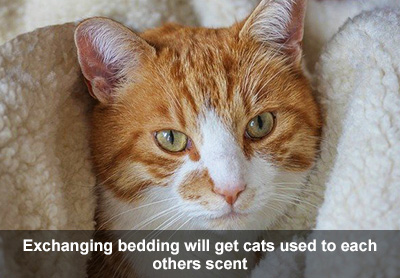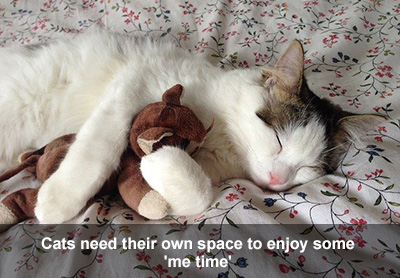Feline Hierarchies
 Cats are often believed to be less social than humans or dogs, but they are very intelligent and they learn to adapt to new environments quite easily. In fact, data collected over the last 20 years shows that domestic cats are indeed quite social and are flexible in their sociability. So cats tend to form hierarchies and learn to live in environments with other cats, pets and of course humans.
Cats are often believed to be less social than humans or dogs, but they are very intelligent and they learn to adapt to new environments quite easily. In fact, data collected over the last 20 years shows that domestic cats are indeed quite social and are flexible in their sociability. So cats tend to form hierarchies and learn to live in environments with other cats, pets and of course humans.
However, introducing two cats to each other can prove to be a lengthy process, especially if both are adults. This is mainly because the hierarchy system of cats is a rather complex process. Sometimes you may be lucky and the cats will get on straight away, but depending on the individual cats' natures the process can take several weeks - or even months. The key is gentle perseverance and understanding.
How Animal Hierarchies Work
With dogs (and wolves) the hierarchy system is called 'absolute': each individual has a place in the system which is in force in all situations, until they win a better place or are 'fought down' by another individual.
Cats on the other hand have what is called a relative hierarchy: each individual has a different position depending on time, place, and situation. In this type of hierarchy there is a top cat who will become the one 'in charge'. This is not always a straight-forward matter since there will be different leaders with different 'responsibilities' depending on the situation and environment. For example, among indoor cats the leader will be the one who receives visitors in the hall and checks if they are dangerous, takes care of other cats or humans, and investigates anything new and interesting. Therefore it is not always the biggest and strongest cat who becomes leader, but usually the one who has one of the following qualities: intelligence, the ability to stay calm in stressful situations, calm, natural authority etc.
The purpose of the hierarchy is to make sure that the cats work with as little aggression as possible when sharing the same environment.
Introducing a New Cat to Resident Pets
Cats are territorial and they need to be introduced to other animals very slowly in order to give them time to get used to each other. Slow introductions can prevent problems and conflicts from developing. The incoming cat will rarely be a problem as it is going into strange territory, it is usually the resident cat who may display initial hostility to the newcomer.
It is important that you have realistic expectations when introducing a new cat to resident cats or other pets. Some cats will get along with other cats or even dogs better than others. An older cat that has never been around other animals may never learn to share her territory (and her people) with other pets in the household. However, a kitten separated from her mother and siblings for the first time will prefer to have another cat or dog companion. Provided introductions are carried out carefully, most cats will accept another cat within a month or so.
Cats and dogs living together: Many cats and dogs can happily live in the same home. It’s important however, to properly manage their introductions, as negative experiences can sour the future relationship. Read our 7 Top Tips to help cats & dogs live in harmony, on our Cats & Dogs Living Together blog post.
The 3 Key Steps to Introducing a New Cat
1. The confinement stage
At first, the new cat should be confined to one room, ideally a little-used room such as a spare bedroom, along with a litter tray, food and water bowls, a bed, scratching post, hiding places and of course toys. The new cat should be left to explore the room on her own, as it will become her comfort zone for the next few days, in some cases longer. A cats anxiety level is largely controlled by the confidence they have in maintaining control of their territory, so a cat will be less stressed if they are left alone at first, and also if they only have to cope with a small environment to begin with.
Once the new cat is relaxed enough to start eating and toileting normally, then the next step is to start feeding your resident cats and the newcomer on opposite sides of the door to this room. This will help them both to associate something enjoyable (eating!) with each other's smells. Gradually move the bowls closer to the door until the pets can eat calmly on either side of the door. Another good trick is to tie a toy, such as a catnip mouse, to each end of a shoelace or piece of string, and thread it under the door. In this way the cats can begin to play 'with' each other, without actually coming face-to-face.
Please see The 'Bonding Room' for full details of the confinement stage
2. Swapping of scents
 Switch sleeping blankets between the resident cats and the newcomer, or even rub a soft towel on the new cat (without upsetting him) and then place it somewhere in the room where the other cats can sniff it. Once the new cat feels relaxed and at home, allow him to explore the rest of the house while at the same time allowing the other pets to visit the new cat's room, still keeping the door to the bonding room closed at this stage. To a cat, scent is more important than sight in the first few days.
Switch sleeping blankets between the resident cats and the newcomer, or even rub a soft towel on the new cat (without upsetting him) and then place it somewhere in the room where the other cats can sniff it. Once the new cat feels relaxed and at home, allow him to explore the rest of the house while at the same time allowing the other pets to visit the new cat's room, still keeping the door to the bonding room closed at this stage. To a cat, scent is more important than sight in the first few days.
This switch allows the cats to experience each other's scents without a face-to-face meeting. It also allows the new cat to become familiar with his new surroundings without being frightened by the other pets.
Be aware that if either pet has a medical condition or is injured, then this could delay the introduction process since cats will pick up different scents.
3. Face to face meeting
The final step should be for the new cat to meet the resident cat(s). This introduction should ideally happen during mealtime. All cats should be fed at the same time but their feeding areas should be in opposite ends of the room. Some growling and hissing should be expected at this point - this is quite normal as they figure out the new pecking order. If either cat seems upset or if a conflict looks likely, they should be separated immediately. Try another introduction when they are both calm. After the cats have finished eating they should be separated straight away.
It's better to introduce the pets to each other gradually so that neither animal becomes afraid or aggressive, although mild forms of these behaviours are to be expected. If either animal becomes fearful or aggressive, separate them, and start over with the introduction process in more gradual steps as before.
During the coming mealtimes the amount of time that they spend in the same room and in each other's company should be gradually increased. Eventually they should be allowed to spend more and more time in the same room (always under supervision) until they are both happy and relaxed with each one's presence. Certainly, they should not be left alone together in the same room unattended (e.g. at night) until the cats have accepted each other.
Preventing Conflicts Between Cats
Try to prevent conflicts: In some cases establishing a hierarchy among cats can be problematic. If any aggression develops between the cats, and their environment does not allow them to give way or hide from each other in tense situations, it can become quite uncomfortable for everyone in the household. The aggressive behaviour can become a learned one which the cat will use again and again if she is not stopped from exhibiting it. It is important that you try and stay one step ahead of the cats, and prevent any fighting from even starting by reading their body language. Try to distract them with a loud noise, even a hissing sound similar to a cat's, or by throwing a toy in the opposite direction. If necessary, separate the cats until they have calmed down.
If a fight breaks out: There can only be one 'top cat' in the household, and cats will work out for themselves who that is. If there is a fight, distract them or calmly intervene, then pick up the aggressor and hug and kiss him/her, rather than the one who just got beaten up (even though you feel sorry for them). Brush the 'top cat' first, feed him first, say hello to him first. This will allow the 'top cat' to reinforce his/her status, making any further conflict less likely.
A 'Feliway Friends' diffuser helps to restore harmony between cats. It contains the 'Cat appeasing pheromone' to help cats get along together. Find out more here: Feliway Friends - helps cats get along.
Giving Each Cat Their Own Space
One way of preventing aggressive behaviour is to make sure that all cats have their own private space to sleep, hide or rest, and that they do not have reasons to fight such as sharing food, litter trays or toys. It is also important that they are distracted so they do not resort to fighting with each other. Having enough stimulation such as sufficient play time, both with toys that they can play with on their own and with you, as well as hidden toys and treats will keep them busy and not give them much opportunity to show aggressive behaviour with each other. Reward your cats when they interact in a positive way.
Cats need sufficient hiding places such as wardrobes, cardboardboxes, spaces behind or between furniture, or commercial tunnels which they can use for hiding and playing. It is also important that they have access to areas above the ground, such as cats' trees, shelves or window sills (so they can watch the goings-on outside occasionally or snooze while soaking up some sun) as they feel safer and in control when they are in high places.
Remedial products
Feliway spray or diffusers help cats feel more calm and relaxed, so can be very helpful when bringing a new cat into your home. You can get Feliway products from your vets, pet supplies shops, or online. There is also a calming spray called 'Pet Remedy' which may help, and is available from most vets.
Further Information:
Introducing a new cat to the home: Please visit our 'Bonding Room Technique' page for full details.
Introducing a cat to a resident dog: Check out our 'Cats & Dogs Living Together' blog post.
Behavioural Advice: Visit our Pet Behaviour links section.
Find Rescue Centres near you: Full list of Cat Rescue & Adoption Centres for the UK & Ireland
Grateful thanks to K. Zurbanu BSc (Hons) (Psych) BSY(PetPsy) for advice and information when compiling this page.
Photo credits: Gundula Vogel / Papagnoc / Gabriele M. Reinhardt / Adina Voicu / Ebowalker from Pixabay



